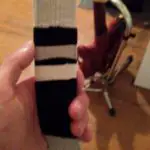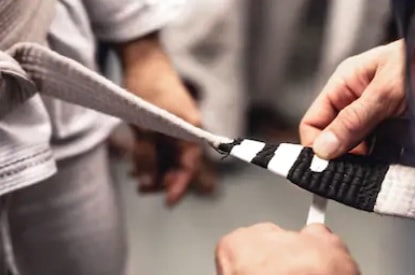
Ever wonder what those stripes mean on a belt in Jiu-Jitsu? Why does one person have 2 while another has 4, and that person over there has none? Who gives them out and how do you get one? In this post, I’ll be going through what these stripes are and what the mean.
The stripes on a belt in Jiu-Jitsu represent the experience, knowledge, and/or skill of the student. The stripes are given out by the instructor and their criteria differ from each school and instructor. Some academies do not give stripes out at all. The stripes you see on a black belt are called degrees and represent time training and teaching at the black belt level.
What Do Stripes Mean In Jiu-Jitsu?
Stripes on Brazilian Jiu-Jitsu belt are used to indicate a student’s level within a given belt rank, which is determined by the professor. Each belt from white to brown can only have 4 stripes on it, after which, the student is promoted to the next belt rank. For example, a 4 stripe white belt has more experience than a 2 stripe white belt.
The stripes you see on a black belt are called degrees. A black belt can have up to 6 degree’s on it. After the 6th degree, a new belt is given for each degree – the coral belts and red belt.
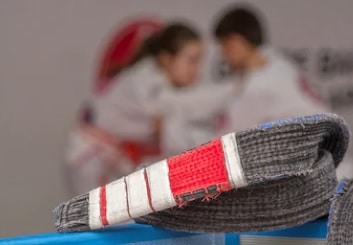
After six degrees a red/black coral belt is given to represent the 7th degree. The 8th degree is represented by a red/white coral belt. And finally, the 9th and 10th degree are represented by a red belt.
The 10th degree (currently) has only been given to the pioneers of Brazilian Jiu-Jitsu.
How Many Stripes Does A Belt Have?
White, blue, purple, and brown belts can have up to four stripes before the next belt rank is given in Jiu-Jitsu. Stripes that are seen on a black belt (and coral and red belts) are referred to as degrees, rather than stripes.
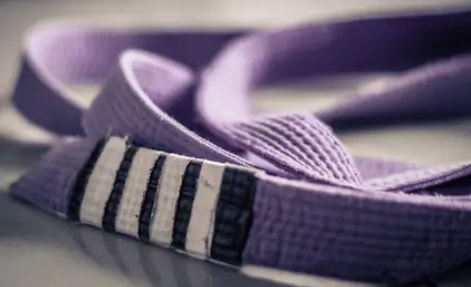
Not all academies give stripes out to their students as they are not required. It is up to the head instructor if they choose to give stripes to their students or not.
The place that I train at only gives stripes out to white belts; whereas blue, purple, and brown belts do not receive any stripes. I have a friend that trains at another place and his Jiu-Jitsu instructor gives out stripes at every belt rank.
How Long Does It Take To Earn A Stripe?
The time it takes to earn a stripe will vary from person to person, stripe to stripe, rank to rank, and professor to professor. Typically a new stripe is awarded every 6-8 months. But, stripes are very subjective to the instructor giving them out so time will vary.
On average a white belt could expect to earn a stripe every 6 months, which would set them on the path to earning their blue belt in 2.5 years.
A blue belt could earn a stripe every 4-5 months to allow them to receive their purple belt in 2 years. According to the IBJJF, a blue belt must be blue for a minimum of 2 years.
In short, the time it takes to earn each stripe will be up to how your instructor and how they determine what the next stripe represents. Is it knowledge, skill, time, or a combination of all of those?
If it has been a while since your last stripe and you’re concerned (you shouldn’t be) ask your instructor about their requirements.
I received my first stripe after 3 months, my second 4 months after that, and my third stripe 6 months after that! As you can see, it can vary quite a bit! Just focus on training and learning and the rest will come.
What Does It Take To Earn Your First Stripe?
The best way to earn your first stripe in Jiu-Jitsu is to train consistently, focus on the techniques taught, learn the fundamentals, and remember that earning your first stripe will depend on the criteria of the instructor giving them out.
Focusing and trying to implement the techniques being taught will help you progress in Jiu-Jitsu much quicker than always using what you already know. Taking notes on the techniques you’ve learned can help you remember what you’ve learned and details you may forget!
Learn the fundamentals techniques of Jiu-Jitsu. Many of these fundamentals are found during the warm-up, like shrimping and bridging.
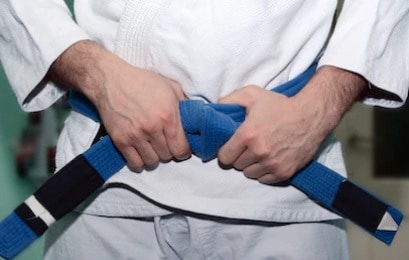
Additionally, knowing the different positions in Jiu-Jitsu will help you recognize what type of situation you are in. If you want to get a quick break down of the basic positions in Jiu-Jitsu I have an article going through them, here!
Finally, if you’re concerned with what it takes to get your first stripe, ask your instructor what they expect you to know. They may require you to be training with them for 3 months, know 3 basic positions, and be able to demonstrate two escapes and submissions from those positions. The possibilities are endless!
I wrote an article about what it takes to earn your first stripe that goes into it in a little more detail. Feel free to check it out here!
Are Stripes Important?
We as Jiu-Jitsu practitioners should not put importance on our stripes. For your instructor, stripes can serve as a reminder of their students’ progression. Whether that is time training, skills, or knowledge.
The reason why we as students shouldn’t put too much importance into the stripes (although it can feel fantastic receiving them) is that they can cause discouragement.
Watching a teammate receive their next stripe, even though you usually tap them, can be frustrating. Especially if the only reason you’re training so hard is to get to the next stripe or promotion.
I’ve read many cases where sometimes the instructor just forgets to give people their next stripe. This is why you shouldn’t put too much thought behind them.
The reason stripes are beneficial for instructors to use is to gauge their students’ skills. Some instructors see a lot of students come through the door. It may be hard for them to keep track of everybody’s progression!
Indicating someone’s skill makes it much easier to match up students based on knowledge and experience.
It can be used for the students to also know what to expect from one another too. For example, a purple belt is going to roll differently with a no stripe white belt and a 2 stripe blue belt.
What Are The Stripes Made Of?
The stripes on a Jiu-Jitsu belt are typically athletic tape that has been wrapped around the black part of the belt. There are some companies that will customize belts to have embroidered stripes in place of the tape.
Conclusion
Stripes in Jiu-Jitsu are used to keep track of a student’s progression at their current rank. Each belt from white to brown can only have up to 4 stripes. After receiving 4 stripes, the student is eligible to get promoted to the next belt rank.
The criteria to receive a stripe differs from professor to professor and from academy to academy. On average a stripe will typically be given out every 6 months. There are some instructors and academies that do not give out any stripes.
The stripes on black belts are called degrees and represent the time spent training at the black belt level.


